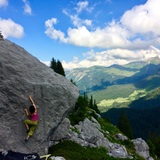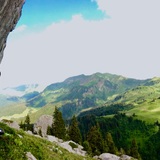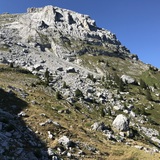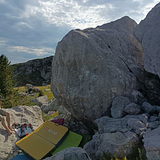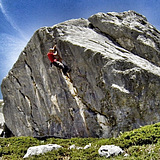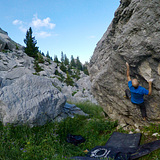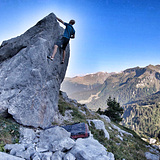Blocs de calcaire entourés des belles montagnes du Bargy, et plus loin des Aravis, tous situés dans un cadre de beauté et de grand calme (sauf peut-être au secteur Prairie, situé sur le sentier très fréquenté). Un cadre magnifique où il n'est pas rare de voir des bouquetins se prélasser autour des blocs.
Altitude : 1660 - 2070 m. Approche : 20-60 min (dénivelé max +450 m).
Dans la zone supérieure, on trouve plusieurs nouveaux secteurs intéressants, ouverts récemment par Timothée Chaboud.
La saison s'étend de mai à octobre, avec une préférence pour septembre-octobre. En juillet-août, et pendant les jours de canicule, il est préférable de grimper le soir, à partir de 18h. La plupart des blocs sèchent rapidement après la pluie. Le secteur Diablotins, le plus éloigné est plus tardivement en conditions , les névés persistant plus longtemps.
Certains blocs sont très hauts et peuvent être essayés en posant une corde (spits au sommet, notamment Attention Fragile ou Magie Noire).
La numérotation reprise ici est issue du topo d’E. Ratouis (2007, 2016). Les numéros à double ont été éliminés ici pour aider la compréhension.
### ENGL
Boulders of limestone surrounded by the beautiful mountains of the Bargy chain, and further away the Aravis, all located in a setting of beauty and great calm (with the exception of sector Prairie, which is on the busy trail). A magnificent setting where it is not uncommon to see ibexes relaxing around the boulders.
Alt. 1660 - 2070 m. Approach: 20-60 min (max elevation +450 m).
In the upper zone there are several new interesting sectors, opened recently by Timothée Chaboud.
The season extends from May to October, with a preference for September-October. In July-August, and during heatwave days, it is best to climb in the evening from 6 p.m. Most blocks dry quickly after rain.
The Diablotins sector, the furthest away, is in conditions later, the snowfields persisting longer.
Some blocks are very high and can be tried by using a rope (bolts on top, notably Attention Fragile or Magie Noire).
The numbering used here comes from the topo by E. Ratouis (2007, 2016). Numbers in double have been eliminated to help understanding.
